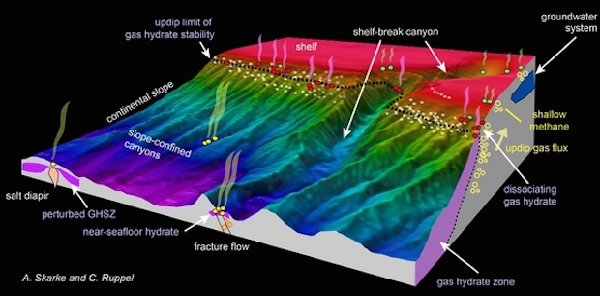Widespread Methane Leakage found in Atlantic Ocean
| Paula Marie Navarra | | Aug 27, 2014 10:50 AM EDT |
Researchers from the University of Mississippi have found widespread leakage of natural methane in the Atlantic Ocean. They expressed concern the seepng methane gas could contribute to already worsening climate change warming.
Methane plumes were emanating from 570 sea floor cold seep vents on the outer continental shelf in the water column on Cape Hatteras, North Carolina and Georges Bank, researchers said.
Like Us on Facebook
Cold seeps occur when gases and fluids leak into the water from sediments. They can occur in a broader range of environments than hydrothermal vents.
The coldness of the cold seeps differs from hydrothermal vents which form hot fluids on the sea floor called the oceanic crust.
These areas found between the Atlantic Ocean and coastline constitute to the continental margin, they added.
Previous researchers found only three cold seep areas beyond the edge of the continental shelf that occurred 590-feet down in deep water on the Atlantic sea floor off the U.S. coast.
Adam Skarke, one of the researchers for this study, said that scientists have not expected a widespread seepage on the Atlantic Margin.
However, he stressed that the seepage was not located near plate tectonic boundaries like US. Pacific coast and did not associated with petroleum basins like northern Gulf of Mexico.
Researchers said that the methane lay close to the shallowest part of the ocean where deep water marine gas hydrate exists on the continental slope.
Gas hydrates are an ice like combination of methane and water that occurs naturally, they explained.
This ice like structure forms at temperature and pressure that were commonly found in water deeper than 1640 feet.
Carolyn Ruppel, one of the researchers, said that gas hydrates release methane when the span of warming of the ocean temperature takes longer.
She stressed that this is the first time continental slope seeps in a mid-latitudes because most seeps are too deep for the methane to reach the atmosphere.
To date, researchers are still finding out what gas the seeps are emitting. They also theorize that the methane leak was produced by microbial processes found in shallow sediments.
©2015 Chinatopix All rights reserved. Do not reproduce without permission
EDITOR'S PICKS
-

Did the Trump administration just announce plans for a trade war with ‘hostile’ China and Russia?
-

US Senate passes Taiwan travel bill slammed by China
-

As Yan Sihong’s family grieves, here are other Chinese students who went missing abroad. Some have never been found
-

Beijing blasts Western critics who ‘smear China’ with the term sharp power
-

China Envoy Seeks to Defuse Tensions With U.S. as a Trade War Brews
-

Singapore's Deputy PM Provides Bitcoin Vote of Confidence Amid China's Blanket Bans
-

China warns investors over risks in overseas virtual currency trading
-

Chinese government most trustworthy: survey
-

Kashima Antlers On Course For Back-To-Back Titles
MOST POPULAR
LATEST NEWS
Zhou Yongkang: China's Former Security Chief Sentenced to Life in Prison

China's former Chief of the Ministry of Public Security, Zhou Yongkang, has been given a life sentence after he was found guilty of abusing his office, bribery and deliberately ... Full Article
TRENDING STORY

China Pork Prices Expected to Stabilize As The Supplies Recover

Elephone P9000 Smartphone is now on Sale on Amazon India

There's a Big Chance Cliffhangers Won't Still Be Resolved When Grey's Anatomy Season 13 Returns

Supreme Court Ruled on Samsung vs Apple Dispute for Patent Infringement

Microsoft Surface Pro 5 Rumors and Release Date: What is the Latest?










